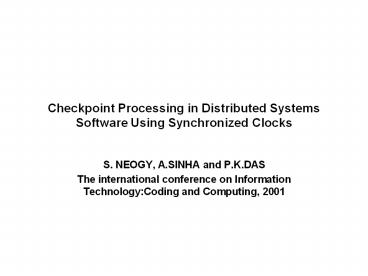Checkpoint Processing in Distributed Systems Software Using Synchronized Clocks PowerPoint PPT Presentation
1 / 7
Title: Checkpoint Processing in Distributed Systems Software Using Synchronized Clocks
1
Checkpoint Processing in Distributed Systems
Software Using Synchronized Clocks
- S. NEOGY, A.SINHA and P.K.DAS
- The international conference on Information
TechnologyCoding and Computing, 2001
2
Introduction
- The method of taking checkpoints in a truly
distributed manner has been very tricky - Assume
- The system uses a fault-tolerant hardware
platform - A synchronization layer guarantees the
synchronization of the individual clocks - There exists a constant Dmax such that at the kth
resynchronization interval (kgt0) for all correct
clocks i j, if the logical clocks of the
processes Pi and Pj be denoted by Cik and Cjk,
then , Cik(t) - Cjk(t) lt Dmax
3
Checkpoint Model
- Logical clocks of the processes are at most Dmax
apart from each other - Each process maintains a message log in the form
of (message id, sender/receiver id) - Since communication is synchronous, processes may
be blocked for send/receive. Checkpointing
instant may occur during the blocked period.
Blocked processes take checkpoints after they
unblock - An unblocked process takes its checkpoint when
the checkpointing instant occurs. After taking
the checkpoint it freezes itself and waits for
the next clock resynchronization message
4
Algorithm
- Procedure check(Pm)
- if (Pm is not blocked ) then
- take_checkpont(Pm) wait(Pm) until
clock_synchronization(Pm) - append the following with the clock
synchronization message - i. checkpoint_commit_signal ii.
message_log - send clock_synchronization_message to Pk
where k 0,1,2,.. - resume(Pm)
- else / Pm isblocked /
- wait(Pm) until unblocked
take_checkpoint(Pm) - wait(Pm) until clock_synchronization(Pm)
- append the following with the clock
synchronization message - i. checkpoint_commit_signal
- ii. message_log
- send clock_synchronization_message to Pk
where k 0,1,2,.. - resume(Pm)
5
Example(1)
CPik-1
CPik
Xi
Pi
e1ij
e2ij
CPjk
CPjk-1
Pj
Xj
e2ij
e1ij
6
Example(2)
CPik-1
Xi
CPik
Pi
e1ij
e2ij
CPjk
CPjk-1
Pj
Xj
e2ij
e1ij
CPik-1
Xi
CPik
Pi
e1ij
e2ij
CPjk-1
CPjk
Pj
Xj
e2ij
e1ij
7
Conclusion
- Synchronised clock-based checkpointing method
- No central checkpoint coordinator
- Only one checkpoint needs to be stored in the
stable storage - The system does not have to roll back more than
once to restart from a previous consistent state
in case recovery is required

